 Jay and I got good looks at the shrike as soon as we
arrived. It was a very active hunter, foraging from poles, power
lines, and shrubs.
Jay and I got good looks at the shrike as soon as we
arrived. It was a very active hunter, foraging from poles, power
lines, and shrubs. Loggerhead Shrike, Lanius ludovicianus, Armitage Road, Wayne/Seneca Co., NY, 20 May 2000.
These pictures were taken by my son Jay and me with an Olympus D-450 digital camera through my Swarovski HD-80 spotting scope on 20 May 2000. Specimen pictures were taken with the same camera (without the use of the spotting scope) at the Cornell University Museum of Vertebrates.
All photographs © Kevin J. McGowan
 Jay and I got good looks at the shrike as soon as we
arrived. It was a very active hunter, foraging from poles, power
lines, and shrubs.
Jay and I got good looks at the shrike as soon as we
arrived. It was a very active hunter, foraging from poles, power
lines, and shrubs.
It was clearly a Loggerhead Shrike and not a Northern, based on the completely black lower mandible, very rounded ("cute") head, and lack of barring on the chest. The area where the black mask was "supposed" to meet over the bill didn't look too black to me. On examination of the specimens in the Cornell University Museum of Vertebrates, I found that the amount of black over the bill and the amount of black in the face mask was variable, and perhaps not extremely helpful in distinguishing the two species (see below).
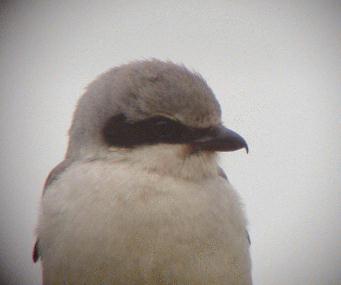
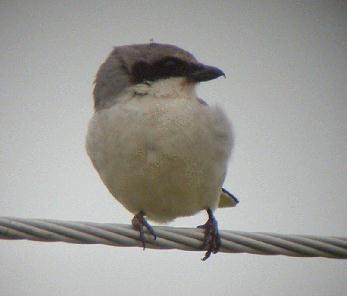
Note the rounded head, that kept the overall appearance "cute, even when the crown was flattened. The bill, though amply hooked, was rather short.

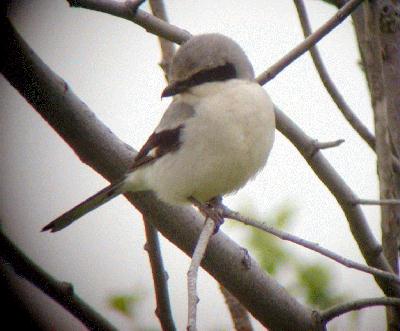
Looking at specimens showed that (as usual) a great deal of variation exists in bill size and shape, and the extent of the black mask over the face.

These specimens are all Loggerhead Shrikes from New York, and you can see the variation in bill size and shape.
Still, none of them approach the large bill of Northern Shrike.

These Northern Shrikes (L. excubitor) from New York show some variation themselves, but all have larger bills than those of the Loggerheads.
A direct comparison of Loggerhead and Northern specimens shows just how different they are.
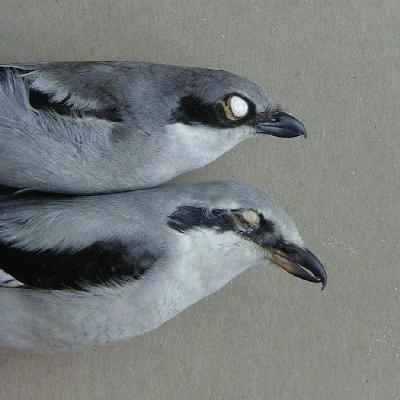
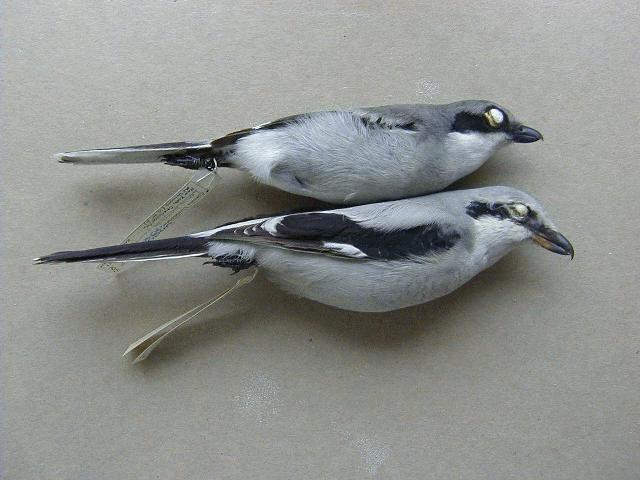
 As I
indicated above, however, the black meeting over the bill or not
did not seem to be a very useful character. Compare these two
specimens of the two species:
As I
indicated above, however, the black meeting over the bill or not
did not seem to be a very useful character. Compare these two
specimens of the two species:
Here are a small series of Loggerhead foreheads. Note that they go from being pretty black over the bill to gray. (The bird on the far left is from Arizona.)
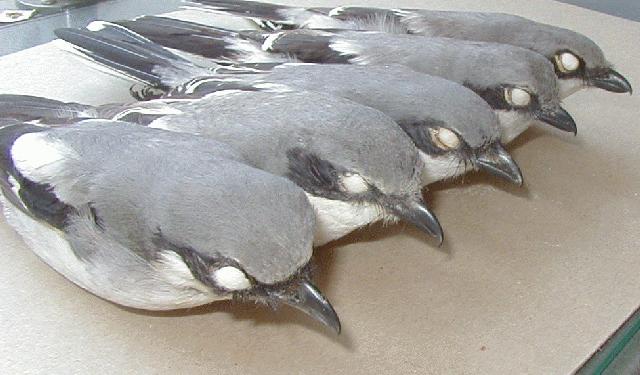
Compare that to the Northern Shrikes:

So I would say that if you see black over the bill, it is a good indication of Loggerhead status, but that some Loggerheads might be gray.
While looking at the skins I saw a couple of
other interesting points. All the specimens of Northern Shrike we
have from North American have some barring on the chest. Just how
much each had was variable. This series shows the extremes of
barring present.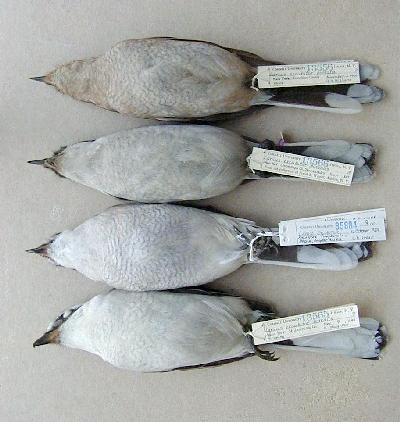
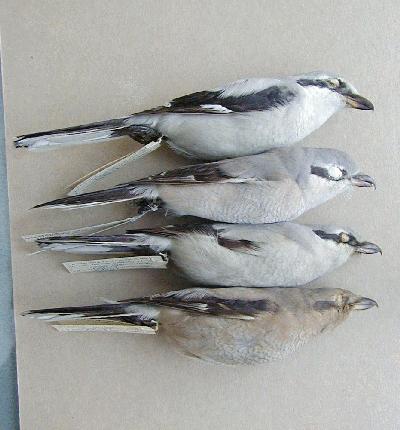

It also should be noted that juvenal plumaged Loggerhead Shrikes have chest barring and can look like petit Northern Shrikes. (We should be so lucky as to see a juvenile Loggerhead in New York!)
The backs of young Loggerheads should be gray and barred, while any barred gray Northern will have an unbarred back.
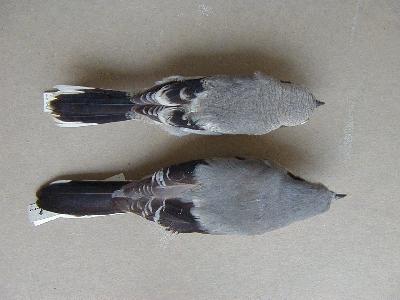
It is interesting to note that our "Northern Shrike" is actually rather cosmopolitan, being found in northern Eurasia, Northern Africa, the Middle East, and into India, where it is known as Great Gray Shrike. (The southern populations are sometimes separated into a different species L. meridionalis, the Southern Gray Shrike.) Only the North American forms appear to have barring in adults. Below are specimens from (top to bottom) India, Austria, and New York.
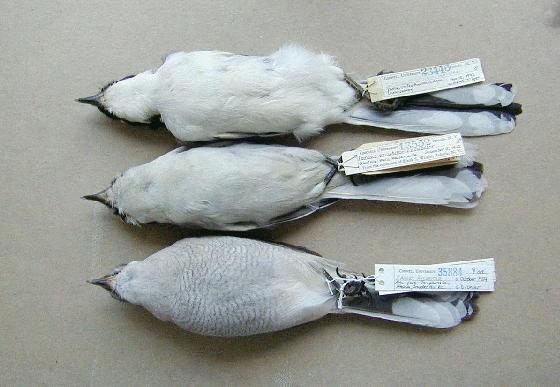
Note that the Indian specimen is strikingly different in the length of tail and the extent of white on the wings, as well as appearing brighter white on the chest and belly.
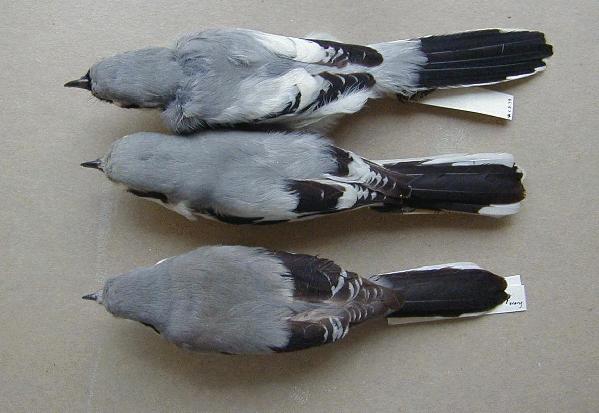
The Indian specimen also shows extensive black over the bill, unlike the other specimens. Quite a striking bird!
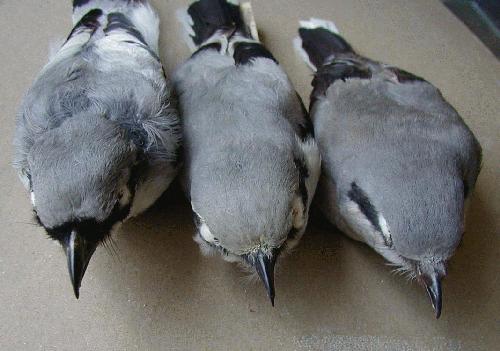
Return to the Bad Photos page.
Return to Kevin McGowan's Home Page.
Return to the Uses of a Collection page.
Return to Cornell University Museum of Vertebrates Ornithology Collection home page.
Go to the Crow Page.